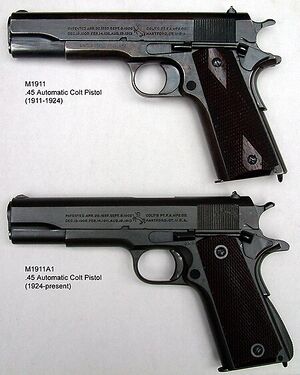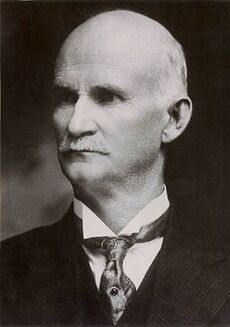Weapons:M1911
| Automatic Pistol, Caliber .45, M1911 | |
|---|---|
 M1911 and a M1911A1, both manufactured by Colt | |
| Type | Semi-automatic pistol |
| Place of origin | United States |
| Service history | |
| In service | 1911–present |
| Used by | See Users |
| Production history | |
| Designer | John Browning |
| Designed |
|
| Manufacturer | Colt Manufacturing Company, Smith & Wesson, Norinco, other companies |
| Unit cost | $26.38 (1938), equal to $571 now |
| Produced | 1911–present |
| No. built | 2,734,345 (produced by Colt) 4,294,345 (total including licensed copies) |
| Variants |
|
| Specifications | |
| Mass | 39 oz (1,100 g) empty, with magazine |
| Length | 8.5 in (216 mm) |
| Barrel length |
|
| Cartridge | .45 ACP |
| Action | Short recoil operation |
| Muzzle velocity | 830 ft/s (253 m/s) |
| Effective firing range | 50 m (160 ft) |
| Feed system | 7-round or 8-round (.45 ACP) box magazine |
The Colt M1911 (also known as 1911, Colt 1911 or Colt Government in the case of Colt-produced models) is a single-action, recoil-operated, semi-automatic pistol chambered for the .45 ACP cartridge.The pistol's formal U.S. military designation as of 1940 was Automatic Pistol, Caliber .45, M1911 for the original model adopted in March 1911, and Automatic Pistol, Caliber .45, M1911A1 for the improved M1911A1 model which entered service in 1926. The designation changed to Pistol, Caliber .45, Automatic, M1911A1 in the Vietnam War era.
Designed by John Browning, the M1911 is the best-known of his designs to use the short recoil principle in its basic design. The pistol was widely copied, and this operating system rose to become the preeminent type of the 20th century and of nearly all modern centerfire pistols. It is popular with civilian shooters in competitive events such as the International Defensive Pistol Association and International Practical Shooting Confederation.
The U.S. military procured around 2.7 million M1911 and M1911A1 pistols during its service life. The pistol served as the standard-issue sidearm for the United States Armed Forces from 1911 to 1985. It was widely used in World War I, World War II, the Korean War, and the Vietnam War. The M1911A1 was replaced by the adoption of the 9mm Beretta M9 pistol as the standard U.S. military sidearm in 1985. However, the U.S. Army did not officially replace the M1911A1 with the Beretta M9 until October 1986, but shortages in production and procurement kept the 1911A1 in service with some units past 1989. The 1911A1 has never been completely phased out. Modernized derivative variants of the M1911 are still in use by some units of the U.S. Army Special Forces, U.S. Marine Corps and the U.S. Navy.
History
Early history and adaptations
The M1911 pistol originated in the late 1890s as the result of a search for a suitable self-loading (or semi-automatic) pistol to replace the variety of revolvers in service at the time.
The United States was adopting new firearms at a phenomenal rate; several new pistols and two all-new service rifles (M1892/96/98 Krag and M1895 Navy Lee), as well as a series of revolvers by Colt and Smith & Wesson for the Army and Navy, were adopted just in that decade.[citation needed]
The next decade would see a similar pace, including the adoption of several more revolvers and an intensive search for a self-loading pistol that would culminate in the official adoption of the M1911 after the turn of the decade.[citation needed]
Hiram S. Maxim had designed a self-loading rifle in the 1880s, but was preoccupied with machine guns. Nevertheless, the application of his principle of using cartridge energy to reload led to several self-loading pistols in 1896. The designs caught the attention of various militaries, each of which began programs to find a suitable one for their forces. In the U.S., such a program would lead to a formal test at the turn of the 20th century.[1]

During the end of 1899 and into 1900, a test of self-loading pistols, including entries from Mauser (C96 "Broomhandle"), Mannlicher (Mannlicher M1894), and Colt (Colt M1900), was conducted.
This led to a purchase of 1,000 DWM Luger pistols, chambered in 7.65mm Luger. During field trials, these ran into some problems, especially with stopping power. Other governments had made similar complaints. Consequently, DWM produced an enlarged version of the round, the 9×19mm Parabellum with fifty weapons chambered for it tested by the U.S. Army in 1903.[2]
American units fighting Tausūg guerrillas in the Moro Rebellion in Sulu during the Philippine–American War using the then-standard Colt M1892 revolver, .38 Long Colt, found it to be unsuitable for the rigors of jungle warfare, particularly in terms of stopping power, as the Moros had high battle morale and often used drugs to inhibit the sensation of pain. The U.S. Army briefly reverted to using the M1873 single-action revolver in .45 Colt caliber, which had been standard during the late 19th century; the heavier bullet was found to be more effective against charging tribesmen. The problems prompted the Chief of Ordnance, General William Crozier, to authorize further testing for a new service pistol.
Following the 1904 Thompson-LaGarde pistol round effectiveness tests, Colonel John T. Thompson stated that the new pistol "should not be of less than .45 caliber" and would preferably be semi-automatic in operation. This led to the 1906 trials of pistols from six firearms manufacturing companies (namely, Colt, Bergmann, Deutsche Waffen und Munitionsfabriken (DWM), Savage Arms, Knoble, Webley, and White-Merrill).
Of the six designs submitted, three were eliminated early on, leaving only the Savage, Colt, and DWM designs chambered in the new .45 ACP (Automatic Colt Pistol) cartridge. These three still had issues that needed correction, but only Colt and Savage resubmitted their designs. There is some debate over the reasons for DWM's withdrawal—some say they felt there was bias and that the DWM design was being used primarily as a "whipping boy" for the Savage and Colt pistols,Hallock, Kenneth R. (1980), Hallock's .45 Auto Handbook. though this does not fit well with the earlier 1900 purchase of the DWM design over the Colt and Steyr entries. In any case, a series of field tests from 1907 to 1911 were held to decide between the Savage and Colt designs. Both designs were improved between each round of testing, leading up to the final test before adoption.
Among the areas of success for the Colt was a test at the end of 1910 attended by its designer, John Browning. Six thousand rounds were fired from a single pistol over the course of two days. When the gun began to grow hot, it was simply immersed in water to cool it. The Colt gun passed with no reported malfunctions, while the Savage designs had 37.
Service history
Following its success in trials, the Colt pistol was formally adopted by the Army on March 29, 1911, when it was designated "Model of 1911", later changed in 1917 to "Model 1911", and then "M1911" in the mid-1920s. The Director of Civilian Marksmanship began manufacture of M1911 pistols for members of the National Rifle Association of America in August 1912. Approximately 100 pistols stamped "N.R.A." below the serial number were manufactured at Springfield Armory and by Colt. The M1911 was formally adopted by the U.S. Navy and Marine Corps in 1913. The .45 ACP "Model of 1911 U.S. Army" was used by both U.S. Army Cavalry troops and infantry soldiers during the United States' Punitive Expedition into Mexico against Pancho Villa in 1916.
- ↑ Hogg & Walter 2004, p. 225.
- ↑ Hogg & Walter 2004, p. 98.